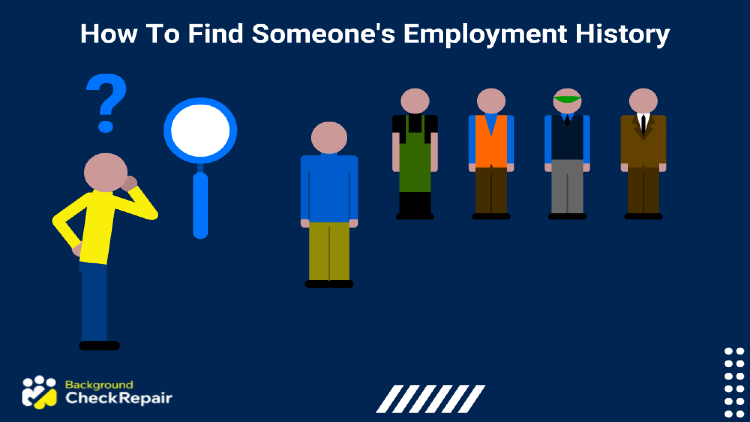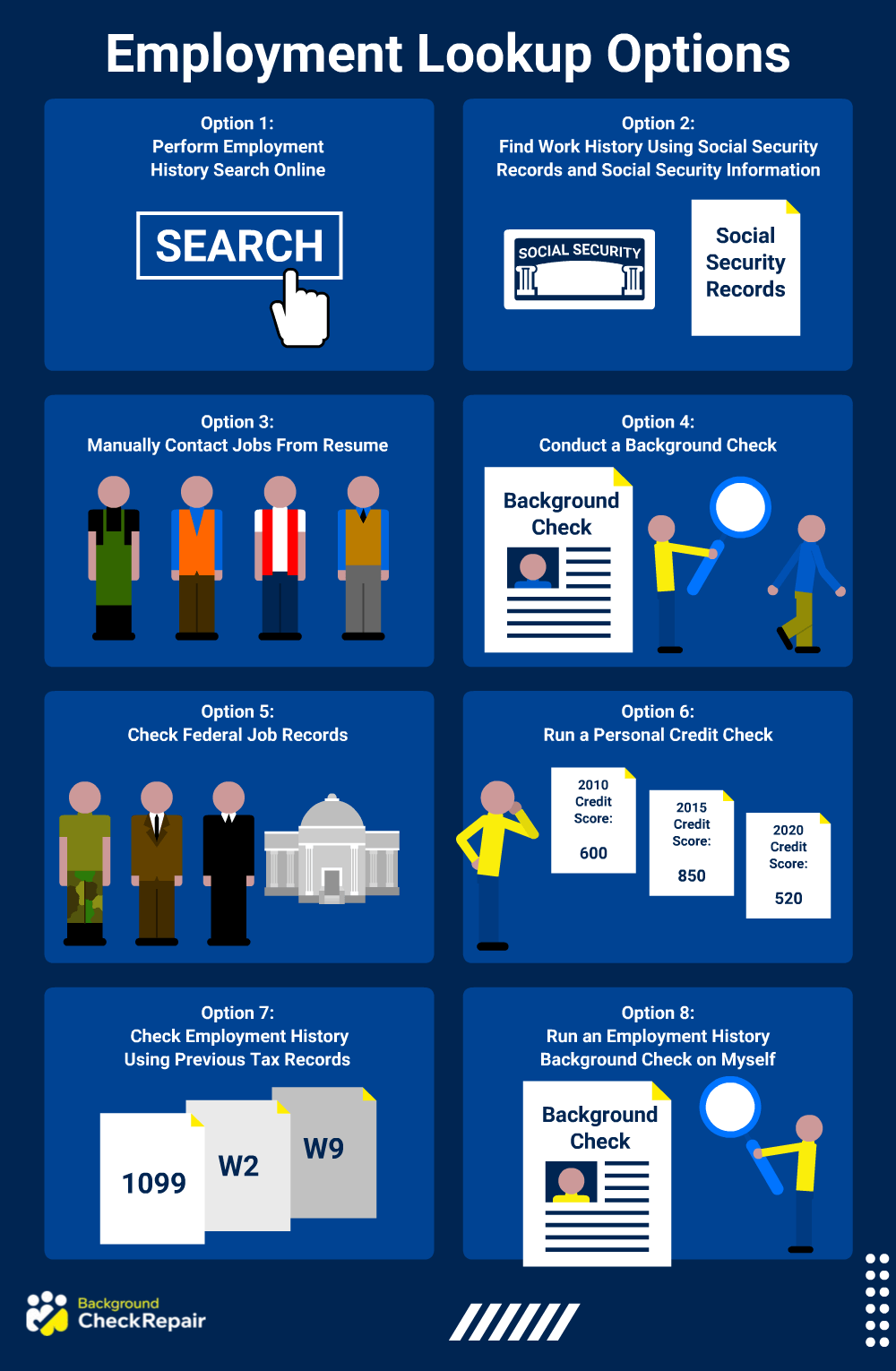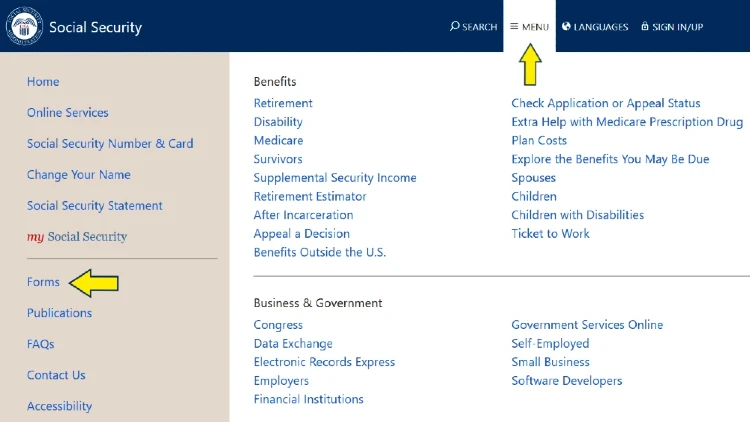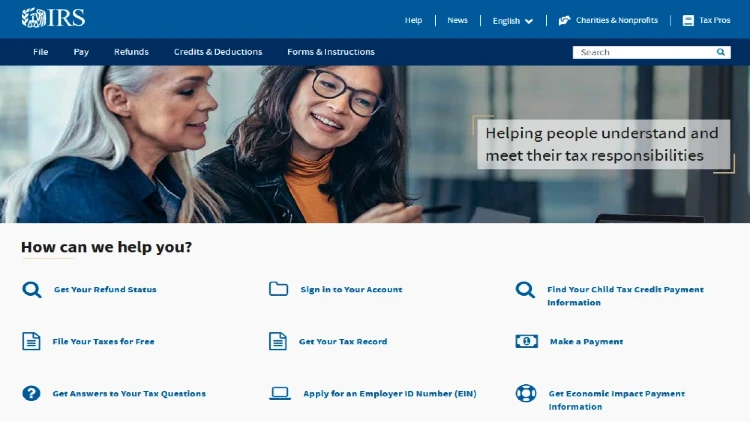How Do I Look Up Someone's Employment History?
The methods outlined above provide effective tools for finding out someone’s work history, including online free options and background check searches.
 Written by Background Check Repair
Written by Background Check Repair
Background Checks | May 16, 2024

Table of Contents
With so many people applying for jobs online, it’s easier than ever to learn how to find someone’s employment history (and current workplace).
These eight options outline the most effective methods for searching work history.
This comprehensive guide explains how to find someone’s employment history and how to check work records right now.
If someone has ever applied to a job online or created profiles on various job posting platforms, the public information about previous employment can be found in a number of ways. When searching the employment history of someone else for a personal reason, users don’t need permission. However, when the search is being done for professional reasons (like a rental application or job), consent is required.

In many cases, this can be done in just a few minutes with searches that are performed with just the individual’s name. (Having the middle name or middle initial is helpful.)
Employers verifying information on an individual’s resume and applicants who want to know what a background check will reveal can also do an internet search for work history results.
With so many jobs being posted exclusively online, most people that are on the job hunt likely have at least one if not several online job profiles. LinkedIn is generally the most common in the United States, so individuals trying to figure out how to find someone’s employment history should probably start there. Keep in mind that Linkedin is not an official record, so any information found on someone’s Linkedin profile was uploaded by that individual. Therefore it is possible that certain jobs may be omitted.
To search for someone’s profile on Linkedin, simply create a free profile and type in the person’s full name.
When learning how to find someone’s employment history, social security records provide the most accurate results. Individuals and employers (who have consented) can check work history information using the Social Security Administration’s website.
Detailed steps for performing a Social Security work history check are outlined below.
Step 1: Access the Social Security Administration Website

(Image: Social Security Administration1)
The Social Security Administration keeps track of a person’s work history throughout their lifetime, in order to return the money paid during their years of work, to the government.
Step 2: Navigate to the ‘Forms’ Page
On the homepage of the SSA website, simply click the drop down menu and select ‘forms.’ this will take users to a page with dozens of different forms that are offered by the SSA for various reasons.
Step 3: Select the SSA-7050-F4 Form
In order to access a person’s work history information through the SSA, a “Request for Social Security Earnings Information Form,” is needed. This form is also known as a SSA-7050-F4 form. Simply scroll down near the bottom of the page and click the provided link to access the form.
Step 4: Complete the Form and Mail It to the Provided Address
Download a physical copy of the form and fill it out by hand. The information that the form requires is self-explanatory and amounts to filling in what information the individual is requesting as well as providing basic information such as a name, address, and social security number.
Once the form has been completed there are detailed instructions provided on how and where to mail it so that the requested information can be returned to the sender.
Keep in mind that the SSA does require a fee for how to find someone’s employment history, which ranges from $30 to $122, based on the information that is being requested.
For employers seeking to verify employment history on an applicant’s resume or application, manually contacting previous employers is usually the most effective method. What information is provided will vary based on the employer and the laws of the state, but most will be happy to talk basics about previous employees and at least confirm their job duties and how long the individual was employed.
How long this method takes will depend on how quickly the employer is able to get back the person making the request.
Conducting a professional background check on an individual is an effective and thorough method for determining an individual’s employment history. Depending on how much information is requested, the time it takes for a background search conducted this way will vary.
Individuals looking for their own background check can explore 7-day free trials offered by the most reputable background check agencies.
It’s important to keep local and state laws in mind when conducting a background check on someone as most jurisdictions require written consent before one is performed.
When working with a background check company, be sure to get the required written consent from the individual and then simply provide the company with the name and usually the social security number of the individual. For a basic check, this shouldn’t take more than a week and in some cases can be completed in as little as 48 hours or less.
For individuals who have worked for federal employers of any kind, there is an additional check that can be run to obtain employment history.
All federal employees have an Employee Personal Page, housed at the Department of Labor. The DOL ensures all workers have access to Labor Net, which manages employment history.
In addition to My EPP, the U.S. Department of Labor houses information on all government employees while they are employed by a government agency in an Official Personnel Folder (OPF). When the employee leaves a government agency for the private sector, the OPF is sent to the National Archives.
To access these records, the person of record can submit a written request. Detailed steps for how to submit a written request can be found on the National Archives Personnel Records page.
For those who are trying to access the records of another individual, written consent must be gathered from the individual in question. In addition to written consent, the individual must also specify exactly what information is being released.

(Image: National Archives2)
Anyone who has been employed by the federal government has their employment history detailed in the national archives, which is available to search.
In certain situations, using a credit reporting agency will be another method for how to find someone’s employment history and previous work history information. Although these agencies don’t keep track of an individual’s work history in its entirety, some information may be available.
For example, if the individual filled in their employment history as part of a loan application, the Credit Reporting Agency should have a record of this information.
Information on safe and legitimate ways to check credit reporting history can be found here.
Although this method will not give the most complete results, individuals can request this information about themselves for free, once a year.
There is also the option to check employment history using previous tax records.
Step 1: Access the IRS website
For individuals who no longer have a copy of their W-2 form, it can be requested through the IRS website. Simply use the provided link to access the website to get started.
Step 2: Navigate to the Forms and Instructions Page
On the homepage of the IRS website is a link to a page titled “Forms and instructions,” where the proper form can be found as well as other important IRS forms.

(Image: Internal Revenue Service3)
The Internal Revenue Service keeps copies of previous W-2s and other tax filing forms and will provide duplicate records for users for a small fee.
Step 3: Access the 4506-T Form
A PDF version of the necessary form can be found on the bottom right of the Forms and Instructions page.
Step 4: Complete and Mail the Form.
Download and complete the form as instructed. The form will ask for basic contact information as well as a mailing address to send the requested documents.
At the bottom of the form are detailed instructions on how and where to send the form so that the W-2s can be sent to the individual.
Knowing the different ways to examine your own background can make finding work history simple, and provide insights into what potential employers will see.
Simply find a reputable background check company that performs the necessary checks, being sure to request employment history information in addition to any other checks that may be worthwhile.
There are a number of ways to find the exact dates of an individual’s previous employment. Some fast methods include:
Most employers will have records that indicate the hire date and the first day worked, as well as records regarding the last day that the individual was employed.
Although different methods will yield slightly different results there are many ways to get accurate and thorough information for how to find someone’s employment history, but the best thing to do is explore the options and pick the one that works best for that specific situation.
The methods outlined above provide effective tools for finding out someone’s work history, including online free options and background check searches.
No. The Department of Labor only manages work history that occurred for the federal government, not any private employers. But anyone can access their pay records and job history using the Labor Net portal.
What’s on the background check for a job will sometimes include previous employers. Typically, this is done by checking references that a job applicant submits on his or her resume.
1Social Security Administration. (2024). Social Security. SSA: The United States Social Security Administration. Retrieved May 17, 2024, from <https://www.ssa.gov/>
2National Archives. (2022, October 31). Official Personnel Folders (OPF),Federal (non-archival) Holdings and Access. National Archives. Retrieved May 17, 2024, from <https://www.archives.gov/personnel-records-center/civilian-non-archival>
3Internal Revenue Service. (2024). IRS. Internal Revenue Service | An official website of the United States government. Retrieved May 17, 2024, from <https://www.irs.gov/>
We use cookies to ensure that we give you the best experience on our website. If you continue to use this site we will assume that you are happy with it